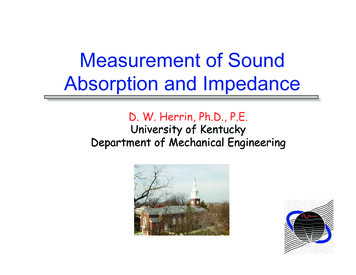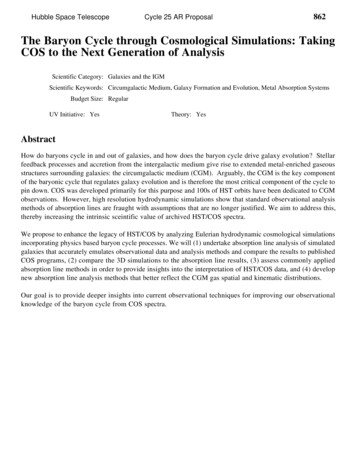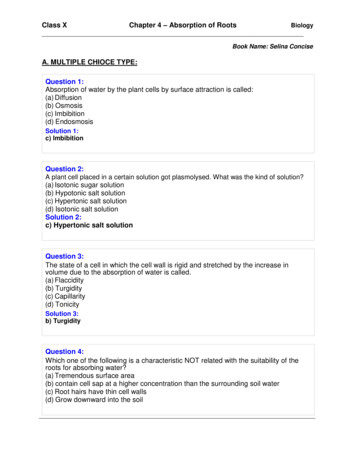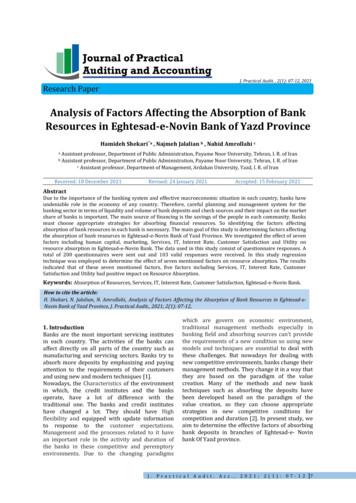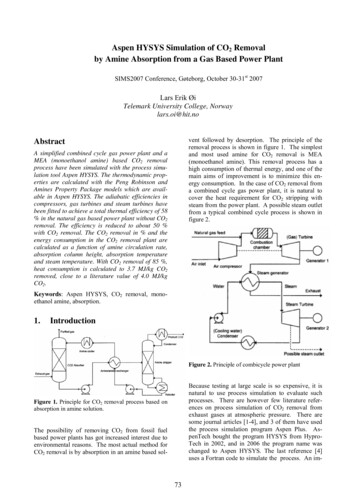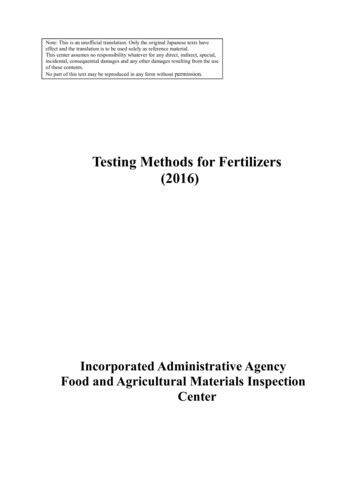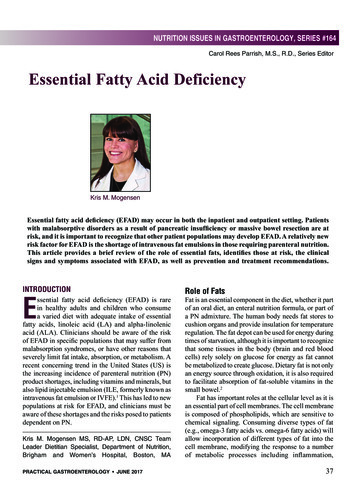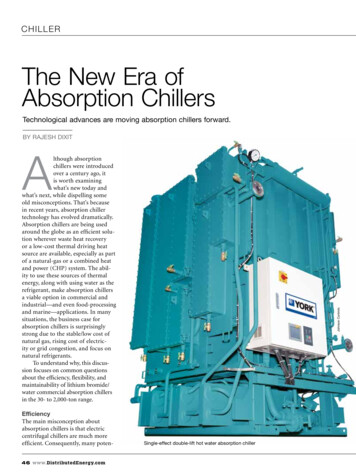
Transcription
C H I L LE RThe New Era ofAbsorption ChillersTechnological advances are moving absorption chillers forward.By Rajesh DixitAEfficiencyThe main misconception aboutabsorption chillers is that electriccentrifugal chillers are much moreefficient. Consequently, many poten46 www.DistributedEnergy.comJohnson Controlslthough absorptionchillers were introducedover a century ago, itis worth examiningwhat’s new today andwhat’s next, while dispelling someold misconceptions. That’s becausein recent years, absorption chillertechnology has evolved dramatically.Absorption chillers are being usedaround the globe as an efficient solution wherever waste heat recoveryor a low-cost thermal driving heatsource are available, especially as partof a natural-gas or a combined heatand power (CHP) system. The ability to use these sources of thermalenergy, along with using water as therefrigerant, make absorption chillersa viable option in commercial andindustrial—and even food-processingand marine—applications. In manysituations, the business case forabsorption chillers is surprisinglystrong due to the stable/low cost ofnatural gas, rising cost of electricity or grid congestion, and focus onnatural refrigerants.To understand why, this discussion focuses on common questionsabout the efficiency, flexibility, andmaintainability of lithium bromide/water commercial absorption chillersin the 30- to 2,000-ton range.Single-effect double-lift hot water absorption chiller
An average US city with averagechiller performance was considered.The chillers in the comparison wereType of ChillerDesign COPIPLV (COP)Electrical Consumption kW/Tonan industry-average, 1,000-ton electricElectric Centrifugal6.510.70.542centrifugal chiller with variable speeddrive, and absorption chillers of threeSingle-Effect Steam0.770.810.01Absorptiondifferent types: single-stage steam,Double-Effect Steam1.371.560.01two-stage steam, and direct fired, withAbsorptiona minimum entering condenser waterDirect Fired Absorption1.371.560.01temperature of 68 F.The model shows that the higherefficiency of an electric chiller doestial customers assume that absorption chillers do not makenot result in a lower operating cost compared to an absorptioneconomic sense because their energy efficiency appears tochiller. In other words, absorption chillers are not necessarilybe lower. This mistaken idea is surprisingly common evenless cost-efficient to operate. That’s because absorption chillersamong chiller experts.are driven by low-cost heat that can lower the cost of operaThe reason behind this misconception can be seen in Figtion and, therefore, provide a faster payback on the capitalure 1, which uses a common measurement of efficiency—theinvestment. This is not to say that absorption chillers are idealcoefficient of performance (COP)—to compare different 1,000- for every application. Each situation must be carefully evaluton systems at Air-Conditioning, Heating, and Refrigerationated before making the right chiller choice. One thing is clear,Institute (AHRI) conditions.In this comparison, it is importantto note that COPs between centrifugalFigure 2: Correlating COP, design point, and energy costs for different 1,000-ton systemsand absorption chillers are calculated inType of ChillerDesign COPElectricalSteam flow rateNatural gas flowConsumptionratea different manner. It is also important toremember that it is the cost of operation, Electric Centrifugal6.50.542 kW/tonNot applicableNot applicablenot academic comparison of COP values,Single-Effect Steam0.770.01 kW/ton14.8 lb/hr/ton @ 15Not applicablethat makes the business case.AbsorptionpsigTo further investigate the cost-effecDouble-Effect Steam1.370.01 kW/ton8.5 lb/hr/ton @ 115Not applicablepsigtiveness of an absorption chiller, consider AbsorptionDirect Fired Absorption1.20.01 kW/tonNot applicable10 ft /hr/ton*how COPs correlate with actual energycosts as shown in Figure 2.* Assuming a higher heating value of 1,000 BTU/ftThis comparison assumes that botha centrifugal and an absorption chillerare working at design conditions with their respective COPs.however—that low-cost thermal driving heat source must beAlso, it assumes the natural gas cost is fixed at 4/MMBTUavailable. Otherwise, it doesn’t pay to create the driving heatand electric utility costs are 0.1/kWh and 0.2 kWh, respecsource to drive an absorption chiller because it would not betively, with no demand charge (Figure 3).operationally economical.Here’s the conclusion: In both cases, the operating costBased on a first-cost comparison, absorption chillers areof the absorption chiller is significantly less in spite of havindeed more expensive than electric centrifugal chillers. Howing a much lower COP. The point of this simple analysisever, the difference in capital cost is quickly recovered throughis to show that although the numerical COP values of anannual operating savings, as mentioned above. It is importantabsorption chiller are lower than that of electric chillers, itto base the chiller choice not solely on the initial cost, butdoes not necessarily mean that absorption chillers are more rather the life cycle cost that comprises of first cost, mainteexpensive to operate. In fact, the opposite is true, especiallynance cost, and the annual energy cost.when there is low-cost natural gas or waste heat available.Furthermore, in many US citFlexibilityies, the cost of electricity canApplication versatilitybe much higher than the values Figure 3: Simple analysis of ton-hour costs of absorptionAbsorption cooling technolchiller fired by natural gas vs. an electric centrifugal chillerused in the analysis.ogy has evolved over the years,As additional evidence ofresulting in much greaterNatural Gas FiredElectric Centirfugal Chiller Difference %Absorption Chiller cents/ton-hourcost-effectiveness, an analysisflexibility for deployment incents/ton-hourof annual operational cost wasvast numbers of comfort and5.41 at 0.1 kWh electricity cost26%performed using a computerized 4.0industrial process cooling4.010.82 at 0.2 kWh electricity cost63%modeling tool (Figure 4).installations—and even aboardFigure 1: Comparing the coefficient of performance (COP) for different 1,000-ton systems33Distributed Energy June 2018 47
Figure 4: Operating cost comparison between centrifugal and absorption chillers attwo different electric energy cost levels, assuming cost of natural gas is 4/MMBTUand steam is waste ( 2/1,000 lb)Level 1energy costsElectricity: 0.1/kWhSteam (waste steam): 2/1,000 lbNatural gas: 4/MMBTUChiller typeElectric CentrifugalSingle-Stage SteamTwo-Stage SteamDirect FiredChiller cost ofoperation 155,382 117,178 67,272 149,775Plant cost ofoperation 249,106 216,823 176,408 258,847Level 2energy costsElectricity: 0.2/kWhSteam (waste steam): 2/1,000 lbNatural gas 4/MMBTUChiller typeElectric CentrifugalSingle-Stage SteamTwo-Stage SteamDirect FiredChiller cost ofoperation 310,765 117,178 67,272 149,775Plant cost ofoperation 498,212 316,468 285,544 367,919passenger cruise vessels. Absorptionchillers have also been successfullyapplied for gas turbine inlet air coolingapplications or hazardous area outdoorapplications, such as in a refinery or apetrochemical plant.Absorption chillers are generallylonger and heavier than electric centrifugal chillers. Nevertheless, for tightspaces or other dimensional constraintsat the job site, it is possible to reducelength and increase width for the samecooling capacity.Operating rangeIn the real world, however, there ismore flexibility in the operationalrange than suggested by the typicalnominal values shown in Figure 5. Asan example, if the unit is working at50% cooling load, the chilled water andthe cooling (condenser) water flow ratemay also be at 50% of the design value.The acceptable rate of change of flow isapproximately 5% per minute.Effect of tube metallurgy and coolingwater inlet temperatureCooling capacity can vary dependingon the tube material, such as copper,CuNi 90:10, SS316, and titanium. However, there will be a deration (7 18%)in cooling capacity if the tube materialis not copper. This deration also occurswhen the cooling (condenser) waterinlet temperature to the absorber section increases above the design value.For an industry-average, two-stage1,000-ton steam-driven absorptionchiller, if the cooling (condenser) watertemperature increases from 85 F to, say,93 F, the cooling capacity may drop toalmost 750 tons (a 25% deration) whilethe COP stays relatively flat.Absorption chillers are being used around theglobe as an efficient solution wherever wasteheat recovery or a low-cost thermal drivingheat source are available.Johnson ControlsDouble-effect steam-firedabsorption chiller48 www.DistributedEnergy.com
Low-NOx applicationsDirect fired units can be provided withultra-low NOx burners to meet emerging stringent emission regulations. It isquite common to apply such a unit as achiller-heater, with cooling-mode operation during the summertime and heating mode operation during the wintertime. Consequently, a single absorptionunit takes care of both the cooling andheating requirement of a facility, therebypotentially eliminating other heatingequipment in the plant room to savespace and capital cost.Simultaneous chilled- and hot-waterproductionAn absorption unit can also bedesigned to operate in simultaneousmode, providing chilled water and hotwater at the same time. In this mode,the preference is generally for cooling, and the hot water is a byproduct useable for domestic hot waterrequirements (for example, in a hotelapplication).Additionally, absorption technology has been successfully applied inheat-pump mode, delivering up to 185 Ffrom the condenser section for districtheating or process heating applications.The typical leaving evaporator temperature is 85 F. The unit is typically drivenby steam, high temperature hot water, ordirect fired.Energy source flexibilityAbsorption chillers can be driven by acombination of direct fired, plus hotwater or steam plus hot water, multienergy units. Even direct exhaust gas ora combination of exhaust gas plus hotwater plus direct gas-fired configurations are possible. Single-effect, doublelift designs can be driven by enteringFigure 5: Typical absorption chiller minimum and maximum operating rangesChilled Water Outletfrom the evaporatorsectionOutlet temperature 39ºF–68ºFFlow rate 1.3–3.0 gpm/tonCooling (Condenser) water inletto the absorber sectionInlet temperature 68ºF–99ºFFlow rate 3.0–8.0 gpm/ton for single stage.Flow rate 2.2–6.0 gpm/ton for two stage.Steam inlet to the generatorsectionInlet pressure 4.5–45 psig for singlestageInlet pressure 30–145 psig for two stageHot water inlet to the generatorsectionUp to 320ºF for single stage (can be aslow as 158ºF)Up to 375ºF for two stagehot water temperature as low as 131 Fwith leaving water temperatures downto almost 104 F. Other designs can provide leaving evaporator fluid temperature as low as 23 F, which is ideal forfood and beverage applications.MaintainabilityNo discussion on absorption cooling technology is complete withoutmentioning crystallization. In the USparticularly, there are some commonmyths about crystallization of lithiumBased on a first-cost comparison, absorptionchillers are indeed more expensive than electriccentrifugal chillers. However, the differencein capital cost is quickly recovered throughannual operating savings.Wanted:energy expertsConsider yourselfthe Einstein ofdistributed energy?Have a passion forsharing your expertisewith the world?Want to contributeto our growingcommunity ofenergy experts?Become a speaker atDistributed Energy June 2018 49FU DE1803 Speaker bulbHeat rejection to the cooling towerAbsorption chillers typically requirea larger cooling tower compared to amechanical chiller with the same capacity. The values in Figure 6 provide anunderstanding of the heat rejection tothe cooling tower.Typically, the heat rejection to thecooling tower for a single-stage and twostage absorption chiller is 29 MBh/tonand 21 MBh/ton respectively.
iStock/Zozulyabromide solution. The fact is that modern absorption chillersare provided with sophisticated PLC controls to ensure thatthe operating lithium bromide salt solution concentrationpercentage is kept away from the crystallization zone.One method uses a combination of two-step evaporatorabsorber and parallel (lithium bromide) flow design, insteadof a series flow or reverse flow designs. In this two-step designemployed by Johnson Controls, the entering absorber sprayFigure 6: Typical absorption chiller heat rejection to the cooling towerCooling (Condenser)water flow rateSingle-EffectAbsorption3.6 gpm/ton85/100.3ºF3.0 gpm/ton85/103.4ºF4.0 gpm/tonDouble-EffectAbsorptionElectric Centrifugal48/98.8ºF85/94.3ºF85/95.4ºFHave you beenfeatured inDistributed Energy?Order high-qualityreprints and e-printsForesterReprints provides you with allthe talent and expertise of the Foresterteam—the designers, the writers,the editors, and the printing.If you or your company have been featuredin Distributed Energy, here’s your chanceto make your mark with a high-qualitypresentation customizedto your specifications,Customizatfor print and web.ionTo get your ForesterReprints quotee-mail: reprints@forester.netor call 805-679-760450 www.DistributedEnergy.comincludes inseyour ad, yo rt ingurand cont ac logot inand adding fo,front cover theof thmagazine. eDE reprint16 25pconcentration is typically only 58 61.5% depending on thetype of unit and design condition. Besides low solution (salt)concentration, the unit operates with the lowest temperatureand pressure in the first stage (high temperature) generatorsection. All of these methods combined provide the best protection against crystallization.This type of low solution (salt) concentration cycle notonly provides superior protection against crystallization butalso ensures lower amounts of non-condensable gases and corrosion, thereby increasing reliability and life of the unit.As such, absorption chillers are relatively easy to operateand maintain. They are a static piece of equipment with veryfew moving parts. Cooling (condenser) water quality mustbe maintained in accordance with manufacturer’s guidelines—which is no different than any other water-cooledchiller. Another important factor is the maintenance of thevacuum; modern absorption chillers are equipped with anautomatic purge system to maintain the vacuum withoutFacilities that are looking for a costeffective cooling and heating solution that can better utilize existingthermal energy sources are givingadvanced absorption chiller technology a second look.operator intervention. The lithium bromide sample shouldbe analyzed once or twice a year, depending on annual hoursof operation, to determine the topping quantity of the corrosion inhibitor. A good understanding of the cycle is important for successful operation and maintenance in accordancewith a manufacturer’s guidance.Every new technological development—from improvedcontrols to advanced materials to modular construction toenlarged operating range to innovative two-step design—hasexpanded the applicability of absorption chillers. Facilities thatare looking for a cost-effective cooling and heating solutionthat can better utilize existing thermal energy sources are giving advanced absorption chiller technology a second look. DERajesh Dixit is the Director of Global Product Management(Thermally Driven Chillers and Heat Pumps), Chiller Solutions,Building Technologies and Solutions for Johnson Controls.
Heat rejection to the cooling tower Absorption chillers typically require a larger cooling tower compared to a mechanical chiller with the same capac-ity. The values in Figure 6 provide an understanding of the heat rejection to the cooling tower. Typically, the heat rejection to the cooling tower for a single-stage and two-


